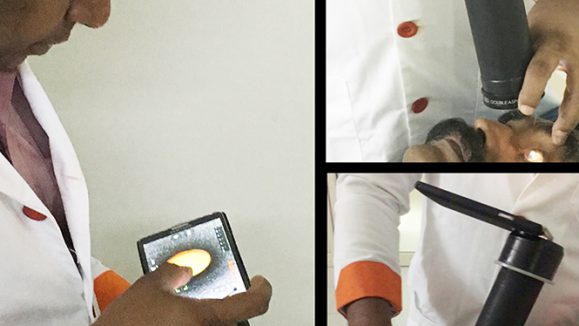When it comes to the latest advancements in posterior segment treatment, we often focus on anti-vascular endothelial growth factor (anti-VEGF), imaging and lasers. However, there are so many other areas worth exploring. Case in point: Gels and nanoparticles. We sat down with Dr. Hudson Nakamura to talk about the role these new technologies might play in shaping the future of posterior segment patient outcomes.
With so many developments in ophthalmology these days, it’s quite surprising that we only tend to focus on a few key advancements — often overlooking some truly fascinating new techniques and technology. Innovative uses of anti-VEGF therapies for numerous conditions continue to generate attention, as do advancements in imaging techniques. Of course, lasers, too, will always capture our attention, not only due to their cool factor but also because of their effectiveness.
Needless to say, it’s easy to see why certain technological developments tend to garner more interest in publications and among ophthalmologists. However, several significant breakthroughs could be slipping under our radar, and we don’t want that!
We spoke with a friend of PIE magazine, Dr. Hudson de Carvalho Nakamura, a vitreoretina specialist from Brazil, to get his expert opinion about these new advances.
Nano drug delivery system in eye care
“Treating retinal diseases could become a challenge if you do not consider delivery systems,” Dr. Nakamura said. “Considering the effectiveness of using nanoparticles, with the advantage of their biodegradable nature, and thus avoiding the need for removal due to their biodegradability, is highly beneficial.”
Take nanocarrier-mediated retinal drug delivery, for example. This technology uses tiny nanoparticles to deliver drugs to areas of the body that can be very resistant to foreign substances. To overcome this barrier, frequent intravitreal injections are currently used to achieve high drug concentrations in the vitreous and retina. But as is known, using these repetitive injections may result in several side effects.
A potential solution could involve utilizing the aforementioned nanoparticles as, compared to the majority of commercially available ocular implants, the biodegradable nature of most nanoparticles eliminates the need for surgical implantation and subsequent removal after the release of the payload.1
“The nanoparticles’ size and their highly modifiable surface properties are characteristics that make them very good candidates for intraocular drug delivery – even those nanocarriers aiming at treating genetic diseases,” continued Dr. Nakamura.
Three researchers based at the University College Cork in Ireland, carried out a review of scientific literature on the efficacy of nanoparticle drug delivery. They examined most studies available on the issue and found that “nanotechnology-based drug delivery systems possess great potential to resolve the shortcomings of existing strategies for drug delivery to the retina.” In particular, they pointed to Ozurdex, manufactured by Allergan, Inc. (Dublin, Ireland), as being particularly promising for clinicians, adding that there’s room for improvement across the board when it comes to low drug loading and possible toxicity issues.1
Polymers for AMD management
Keeping the theme of intraocular drug delivery going, we also looked into the biocompatible reverse thermoresponsive polymer for ocular drug delivery. This novel technique could have several applications in age-related macular degeneration (AMD).
As AMD is one of the most pervasive conditions in modern ophthalmology, with thousands of new patients emerging every year as global populations age, finding new treatments is a major priority for medicine today.
This issue becomes even more evident considering anti-VEGF, the current gold standard for treating the disease, relies on frequent injections directly into the eye (which is not ideal for patient compliance) and is only effective at arresting the progression of the disease.2
“It is very important to rely on intraocular drugs for the treatment of major retinal diseases, such as diabetic retinopathy and AMD, especially with the latter where the primary complication involves choroidal neovascular membranes. It’s just as important to achieve an optimal result with fewer injections and using a better vehicle to deliver the medication to the patient’s eye,” Dr. Nakamura added.
A group of intrepid researchers from Australia also caught Dr. Nakamura’s eye for their investigation of the suitability of a novel reverse thermoresponsive polymer (RTP) as an ocular drug delivery vehicle. They examined RTP as it has a polylacticco-polyglycolic acid backbone, which is structured to have linear polymeric backbones, resulting in a loosely bound gel structure due
to weak intermolecular attractions and entanglements with less solid content. This prevents the long-term encapsulation of drugs within the gel, characterized by initially high burst release and faster ongoing release rates, thereby reducing the window of release period.2
During trials, approximately 67% of bevacizumab, an anti-VEGF, was released during the first 14 days as compared to 10% of aflibercept 2 mg for the same period. Overall, approximately 95% of bevacizumab and 25% of aflibercept were released over the 183-day period covered. The Australian researchers said that the high initial burst release of bevacizumab can be beneficial in ocular drug release, allowing for a rapid increase in intravitreal drug concentration to a therapeutic level. Depletion of the drug in the matrix is a potential concern. However, in their concluding remarks, they stated that RTP is well-suited for use as a sustained drug delivery vehicle in the eyes2 —a sentiment that Dr. Nakamura echoed.
“RTP could actually improve the release curves of drugs such as bevacizumab and aflibercept, while the appropriate biocompatibility of the device could result in the improvement of visual acuity. This should help resolve AMD’s complications using such a good delivery method. There are already good signs for the success of this technique,” Dr. Nakamura enthused.
The pros and cons of hydrogel
Another interesting development in the field posterior segment that deserves our attention is the use of hydrogel. Similar to other techniques covered in this article, hydrogels have the potential to get through those pesky barriers within the eye that make treatment more challenging.
Hydrogels are three-dimensional networks of synthetic or natural polymer chains crosslinked by physical or chemical bonds and are believed to offer numerous advantages compared to other treatments. These include their tissue-mimicking properties, desirable soft nature, and ability to absorb large amounts of water (up to 99% of their weight) while maintaining their structure—thanks to the crosslinks between the hydrophilic polymer chains.3
So what does Dr. Nakamura think? “In the era of intraocular injections, hydrogel formulations may make it more feasible for intraocular drugs to reach the retina and act in maintaining and sustaining therapeutic levels without the need for too many injections. Diseases such as diabetic retinopathy, agerelated macular degeneration and others could be of great benefit for that purpose,” Dr. Nakamura said.
The research3 supports Dr. Nakamura’s position in terms of the potential of hydrogels. However, there are numerous challenges faced by scientists in bringing the technology to full efficacy. There are, for example, numerous problems with initial gel viscosity, hydrogel turbidity, crosslinking strategies, sterilization procedures, storage conditions, and long-term intraocular safety. Also, the continuous down-regulation of VEGF in the eye due to the prolonged release of anti-VEGF from the hydrogel depot might, in the long run, cause undesired side effects.3
However, the same study that points out the above issues surrounding hydrogels also highlights that injectable hydrogels are attractive tools for sustained protein delivery to the back of the eye. More research for hydrogel products is in the pipeline, showing great potential in this area.4-6
Thus, with two proven techniques in the (capsular) bag as it were, and a promising one in the pipeline, there’s a lot to be excited about in the realm of posterior segment drug delivery innovations.3
References
- Alshaikh RA, Waeber C, Ryan KB. Polymerbased Sustained Drug Delivery to the Ocular Posterior Segment: Barriers and Future Opportunities for the Treatment of Neovascular Pathologies. Adv Drug Deliv Rev. 2022;187:114342.
- Balachandra A, Chan EC, Paul JP, et al. A Biocompatible Reverse Thermoresponsive Polymer for Ocular Drug Delivery. Drug Deliv. 2019;26(1):343-353.
- Ilochonwu BC, Urtti A, Hennink WE, Vermonden T. Intravitreal hydrogels for sustained release of therapeutic proteins. J Control Release. 2020;326:419-441.
- Wu Y, Tao Q, Xie J, et al. Advances in Nanogels for Topical Drug Delivery in Ocular Diseases. Gels. 2023;9(4):292.
- Rafel D, Guerrero M, Marican A, et al. Delivery Systems in Ocular Retinopathies: The Promising Future of Intravitreal Hydrogels as Sustained-Release Scaffolds. Pharmaceutics. 2023;15(5):1484.
- Gabai A, Zeppieri M, Finocchio L, Salati C. Innovative Strategies for Drug Delivery to the Ocular Posterior Segment. Pharmaceutics. 2023;15(7):1862.
Editor’s Note: A version of this article was first published in PIE Magazine Issue 27.




